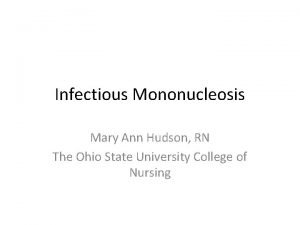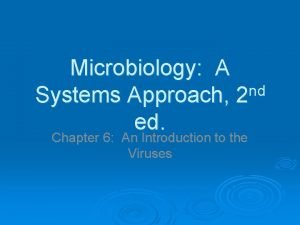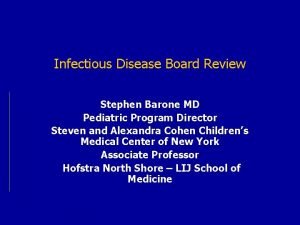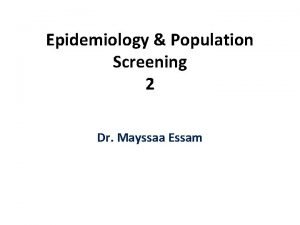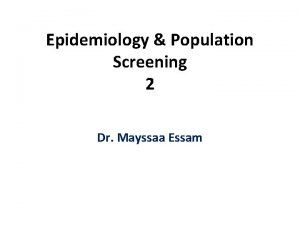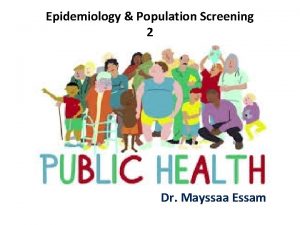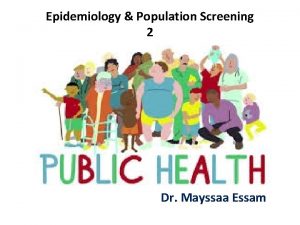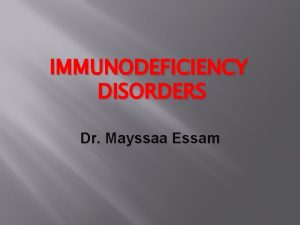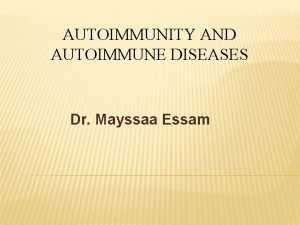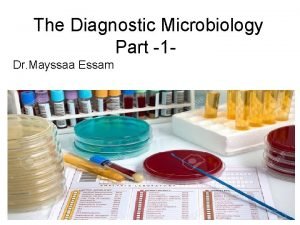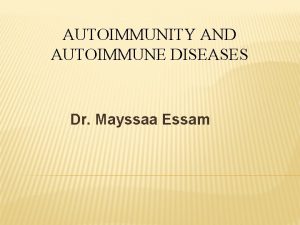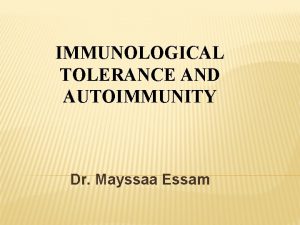Epidemiology Population Screening 2 Dr Mayssaa Essam Infectious

















- Slides: 17

Epidemiology & Population Screening 2 Dr. Mayssaa Essam

■ Infectious diseases and development ■ Epidemiology of communicable diseases. ■ Control of communicable diseases ■ The use of drugs in the control of infections ■ Antimicrobial resistance ■ Surveillance of disease ■ Epidemiology of non-infectious diseases Changes in land water use, deforestation, agricultural development, dams and irrigation schemes can have major positive or negative impact on the pattern of disease. Large outbreaks? ? of communicable diseases periodically occur worldwide.

Herd immunity The level of immunity in the community as a whole is termed ‘herd immunity’. When herd immunity is low, introduction of the infection is likely to lead to severe epidemics, On the other hand, when herd immunity is high, the introduction of infection may not lead to a propagated spread. The current programme for the global elimination of poliomyelitis includes the strategy of mass immunization on national immunization days (NID). The NID approach gives a big boost to herd immunity and helps to eliminate the wild poliovirus from the community.

CONTROL OF COMMUNICABLE DISEASES ESTABLISHING A PROGRAMME A programme for the control of a communicable disease should be based on a detailed knowledge of the epidemiology of the infection and on effective public health organization to plan, execute and evaluate the project. The programme must include some mechanism for: ■ recognizing the infection and the confirmation of the diagnosis. ■ notifying the disease to the appropriate authority. ■ finding the source of infection. ■ assessing the extent of the outbreak by finding other cases and exposed persons.

INCUBATION PERIOD Knowledge of the incubation period of the infection (the interval between infection and onset of symptoms) is of great value in interpreting the data. METHODS OF CONTROL There are three main methods of controlling a communicable disease: ■ eliminate reservoir of infection; ■ interrupt the pathway of transmission; ■ protect the susceptible hosts.

Elimination of the reservoir HUMAN RESERVOIR Where the reservoir is in human beings, the objective would be to find and treat all infected persons, both patients and carriers, thereby eliminating sources of infection. Isolation of patients is indicated for infections which have the following epidemiological features: ■ high morbidity and mortality. ? ? ? ■ high infectivity. ■ no significant extrahuman reservoir. ■ infectious cases easily recognizable. ■ chronic carriers are not a significant part of the reservoir. Quarantine This refers to the limitation of movement of persons who have been exposed to infection. The restriction continues for a period of time equal to the longest duration of the incubation period usual for the disease.

NON-LIVING RESERVOIR Where the reservoir is in soil, elimination of the reservoir is not feasible but it may be possible to limit man’s exposure to the affected area. Interruption of transmission This mostly involves improvement of environmental sanitation and personal hygiene. The control of vectors also depends largely on alterations in the environment and, in addition, the use of pesticidal agents? ? . Protection of the susceptible host This may be achieved by active or passive immunization. Protection may also be obtained by the use of antimicrobial drugs,

Mass campaigns are sometimes indicated for dealing with acute epidemics or as a method of controlling or eradicating endemic diseases. Any vaccine or drug used for a mass campaign must be effective, safe, cheap and simple to apply. Following the emergency operation of a mass campaign. Passive immunization Preformed antibodies are used mainly in the protection of individuals who are at risk of exposure to a specific infection or as treatment for sick patients. Active immunization has evolved to become a powerful tool in public health. In developing countries, vaccination has proved to be a cost-effective approach to disease control requiring relatively simple technology. Vaccination is usually the preferred intervention in those diseases for which effective vaccines are available.

vaccines may contain one of the following: ■ attenuated live organisms (e. g. measles, poliomyelitis); ■ killed organisms (e. g. pertussis, typhoid, cholera); ■ toxins–denatured toxins (e. g. tetanus, diphtheria); ■ genetically engineered vaccines including the use of live carriers. In order to be effective vaccines, the altered live organisms or their products must retain their ability to induce a protective immune response. STRATEGIES FOR USING ACTIVE IMMUNIZATION Routine childhood immunization Routine immunization of children against diphtheria, pertussis, tetanus, measles and tuberculosis is an important tool for the control of these infections and for the promotion of child health.

Epidemic control Vaccines are also used to control outbreaks of diseases. NEW VACCINES Recent advances in immunology, molecular biology and genetic engineering have stimulated new approaches to the development of vaccines. Scientists are now able to identify the process by which immunity is acquired; to identify the antigenic components which induce protective immunity; and to produce relevant biological materials through the cloning of genes or the synthesis of peptides. These developments hold out the prospect of replacing the crude products of traditional vaccines with well-defined antigens. There is also the hope that effective vaccines can be developed against malaria and other parasitic infections.

THE USE OF DRUGS IN THE CONTROL OF INFECTIONS Apart from the treatment of individual patients, antimicrobial agents are used as part of the strategy for controlling infectious diseases. The drug may: ■ protect the uninfected individual. ■ arrest the progression of disease and reverse pathological damage. ■ eliminate infection and thereby prevent further transmission of disease.

These qualities are exploited in the use of drugs for: ■ chemotherapy – the treatment of sick individuals (although the term is also applied more broadly to cover other uses of drugs, including prophylaxis); ■ chemoprophylaxis – the protection of persons who are exposed to the risk of infection, e. g. malaria; ■ chemosuppression – the prevention of severe clinical complications in infected persons.

STRATEGIES Drugs have been used successfully as the main strategy for the control of some endemic diseases. Strategies for large-scale use of drugs in disease control include the following variants: Mass chemotherapy. Selective population chemotherapy. Targeted chemotherapy. DRUG SPECIFICATIONS The ideal drugs for use in developing countries should meet the following specifications: 1. Efficacy. The drug should be effective against all strains of the pathogen; the occurrence or emergence of resistant strains would limit the usefulness of the drug.

2. Safety. The drug can be used safely by health personnel who have limited skills; it can be safely administered to persons who would not remain under continuous medical supervision. 3. Simple regimens. The dosage regimen should be simple administered by mouth; single dose treatments should be available. 4. Acceptable. The drug should be well tolerated by persons of the target age group and should have no unpleasant side-effects. 5. Affordable. The cost of the drug should permit its use within the limited pockets of developing countries.

ANTIMICROBIAL RESISTANCE Antimicrobial resistance has now become a serious • public health concern. The development of resistance is multifactorial namely: (i) Overuse and misuse if antimicrobials by doctors and health personnel. (ii) Poor compliance. (iii) Self-medication. (iv) Counterfeit drugs. (v) Poor control of antimicrobials in hospitals. (vi) Poor standards of hygiene – personal and environmental in hospitals. (vii) Use of antibiotics in animal husbandry, horticulture and aquaculture. (viii) International travel and trade.

EPIDEMIOLOGY OF NON-INFECTIOUS DISEASES Epidemiological methods have been widely applied in the study of non-infectious diseases. Such studies have yielded many fruitful results, especially in providing the basis for taking effective preventive action long before the specific aetiological agent is identified or the mechanism of the pathogenesis of the disease are understood. ■ nutritional disorders (scurvy). ■ cancer (skin, lungs). ■ congenital abnormalities (Down’s syndrome). ■ accidents (home, road and industrial accidents). ■ degenerative diseases (hypertension, arthritis).

REFERENCES • Rowitz, Louis. 2008. Public Health Leadership: Putting Principles into Practice. • A d e t o k u n b o O. L u c a s&H e r b e r t M. G i l l e s. 2003. Short Textbook of Public Health Medicine For the Tropics 4 th edition • “Epidemiology is fundamentally engaged in the broader quest for social justice and equality. ”
 Dr. essam hamza
Dr. essam hamza Population ecology section 1 population dynamics answer key
Population ecology section 1 population dynamics answer key Population ecology section 1 population dynamics
Population ecology section 1 population dynamics Chapter 4 section 1 population dynamics
Chapter 4 section 1 population dynamics Chapter 4 section 1 population dynamics answer key
Chapter 4 section 1 population dynamics answer key Infectious disease
Infectious disease Stages of infectious disease
Stages of infectious disease Poisonous and infectious material symbol
Poisonous and infectious material symbol Smallest infectious agent
Smallest infectious agent Infectious disease quality controls
Infectious disease quality controls Infectious mononucleosis
Infectious mononucleosis Infectious canine hepatitis in dogs
Infectious canine hepatitis in dogs Quizlet
Quizlet Infectious nucleic acid
Infectious nucleic acid Infectious canine hepatitis in dogs
Infectious canine hepatitis in dogs Types of infection
Types of infection Hennepin county infectious disease manual
Hennepin county infectious disease manual Stridor
Stridor










